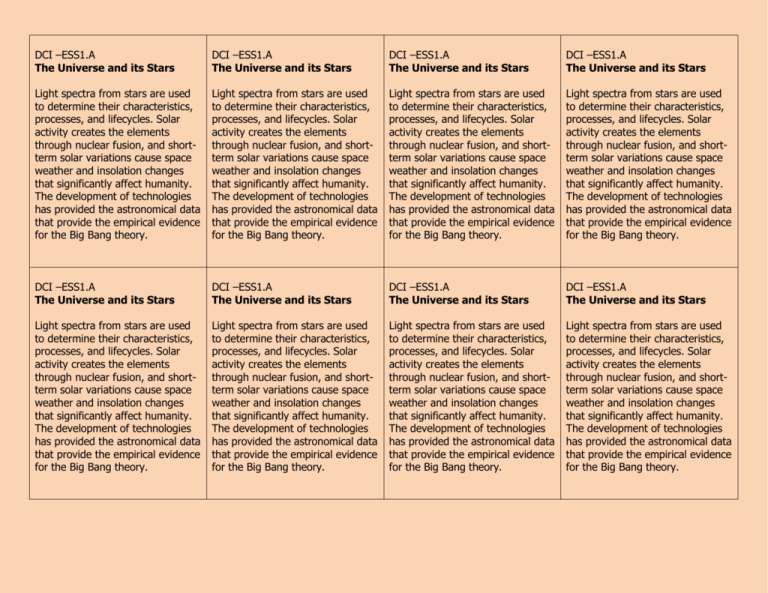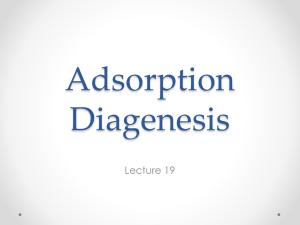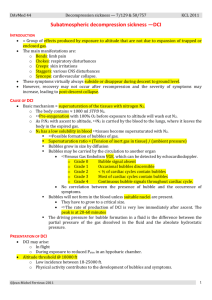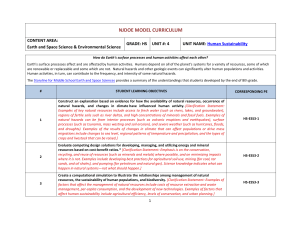DCI Cards - Cloudfront.net
advertisement

DCI –ESS1.A The Universe and its Stars DCI –ESS1.A The Universe and its Stars DCI –ESS1.A The Universe and its Stars DCI –ESS1.A The Universe and its Stars Light spectra from stars are used to determine their characteristics, processes, and lifecycles. Solar activity creates the elements through nuclear fusion, and shortterm solar variations cause space weather and insolation changes that significantly affect humanity. The development of technologies has provided the astronomical data that provide the empirical evidence for the Big Bang theory. Light spectra from stars are used to determine their characteristics, processes, and lifecycles. Solar activity creates the elements through nuclear fusion, and shortterm solar variations cause space weather and insolation changes that significantly affect humanity. The development of technologies has provided the astronomical data that provide the empirical evidence for the Big Bang theory. Light spectra from stars are used to determine their characteristics, processes, and lifecycles. Solar activity creates the elements through nuclear fusion, and shortterm solar variations cause space weather and insolation changes that significantly affect humanity. The development of technologies has provided the astronomical data that provide the empirical evidence for the Big Bang theory. Light spectra from stars are used to determine their characteristics, processes, and lifecycles. Solar activity creates the elements through nuclear fusion, and shortterm solar variations cause space weather and insolation changes that significantly affect humanity. The development of technologies has provided the astronomical data that provide the empirical evidence for the Big Bang theory. DCI –ESS1.A The Universe and its Stars DCI –ESS1.A The Universe and its Stars DCI –ESS1.A The Universe and its Stars DCI –ESS1.A The Universe and its Stars Light spectra from stars are used to determine their characteristics, processes, and lifecycles. Solar activity creates the elements through nuclear fusion, and shortterm solar variations cause space weather and insolation changes that significantly affect humanity. The development of technologies has provided the astronomical data that provide the empirical evidence for the Big Bang theory. Light spectra from stars are used to determine their characteristics, processes, and lifecycles. Solar activity creates the elements through nuclear fusion, and shortterm solar variations cause space weather and insolation changes that significantly affect humanity. The development of technologies has provided the astronomical data that provide the empirical evidence for the Big Bang theory. Light spectra from stars are used to determine their characteristics, processes, and lifecycles. Solar activity creates the elements through nuclear fusion, and shortterm solar variations cause space weather and insolation changes that significantly affect humanity. The development of technologies has provided the astronomical data that provide the empirical evidence for the Big Bang theory. Light spectra from stars are used to determine their characteristics, processes, and lifecycles. Solar activity creates the elements through nuclear fusion, and shortterm solar variations cause space weather and insolation changes that significantly affect humanity. The development of technologies has provided the astronomical data that provide the empirical evidence for the Big Bang theory. DCI – ESS1.B Earth and the solar system DCI – ESS1.B Earth and the solar system DCI – ESS1.B Earth and the solar system DCI – ESS1.B Earth and the solar system Kepler’s laws describe common features of the motions of orbiting objects. Observations from astronomy and space probes provide evidence for explanations of solar system formation. Changes in Earth’s tilt and orbit cause climate changes such as Ice Ages. Kepler’s laws describe common features of the motions of orbiting objects. Observations from astronomy and space probes provide evidence for explanations of solar system formation. Changes in Earth’s tilt and orbit cause climate changes such as Ice Ages. Kepler’s laws describe common features of the motions of orbiting objects. Observations from astronomy and space probes provide evidence for explanations of solar system formation. Changes in Earth’s tilt and orbit cause climate changes such as Ice Ages. Kepler’s laws describe common features of the motions of orbiting objects. Observations from astronomy and space probes provide evidence for explanations of solar system formation. Changes in Earth’s tilt and orbit cause climate changes such as Ice Ages. DCI – ESS1.B Earth and the solar system DCI – ESS1.B Earth and the solar system DCI – ESS1.B Earth and the solar system DCI – ESS1.B Earth and the solar system Kepler’s laws describe common features of the motions of orbiting objects. Observations from astronomy and space probes provide evidence for explanations of solar system formation. Changes in Earth’s tilt and orbit cause climate changes such as Ice Ages. Kepler’s laws describe common features of the motions of orbiting objects. Observations from astronomy and space probes provide evidence for explanations of solar system formation. Changes in Earth’s tilt and orbit cause climate changes such as Ice Ages. Kepler’s laws describe common features of the motions of orbiting objects. Observations from astronomy and space probes provide evidence for explanations of solar system formation. Changes in Earth’s tilt and orbit cause climate changes such as Ice Ages. Kepler’s laws describe common features of the motions of orbiting objects. Observations from astronomy and space probes provide evidence for explanations of solar system formation. Changes in Earth’s tilt and orbit cause climate changes such as Ice Ages. DCI –ESS1.C The history of planet Earth DCI –ESS1.C The history of planet Earth DCI –ESS1.C The history of planet Earth DCI –ESS1.C The history of planet Earth The rock record resulting from tectonic and other geoscience processes as well as objects from the solar system can provide evidence of Earth’s early history and the relative ages of major geologic formations. The rock record resulting from tectonic and other geoscience processes as well as objects from the solar system can provide evidence of Earth’s early history and the relative ages of major geologic formations. The rock record resulting from tectonic and other geoscience processes as well as objects from the solar system can provide evidence of Earth’s early history and the relative ages of major geologic formations. The rock record resulting from tectonic and other geoscience processes as well as objects from the solar system can provide evidence of Earth’s early history and the relative ages of major geologic formations. DCI –ESS1.C The history of planet Earth DCI –ESS1.C The history of planet Earth DCI –ESS1.C The history of planet Earth DCI –ESS1.C The history of planet Earth The rock record resulting from tectonic and other geoscience processes as well as objects from the solar system can provide evidence of Earth’s early history and the relative ages of major geologic formations. The rock record resulting from tectonic and other geoscience processes as well as objects from the solar system can provide evidence of Earth’s early history and the relative ages of major geologic formations. The rock record resulting from tectonic and other geoscience processes as well as objects from the solar system can provide evidence of Earth’s early history and the relative ages of major geologic formations. The rock record resulting from tectonic and other geoscience processes as well as objects from the solar system can provide evidence of Earth’s early history and the relative ages of major geologic formations. DCI – ESS2.A Earth materials and systems DCI – ESS2.A Earth materials and systems DCI – ESS2.A Earth materials and systems DCI – ESS2.A Earth materials and systems Feedback effects exist within and among Earth’s systems. Feedback effects exist within and among Earth’s systems. Feedback effects exist within and among Earth’s systems. Feedback effects exist within and among Earth’s systems. Radioactive decay and residual heat of formation within Earth’s interior contribute to thermal convection in the mantle. Radioactive decay and residual heat of formation within Earth’s interior contribute to thermal convection in the mantle. Radioactive decay and residual heat of formation within Earth’s interior contribute to thermal convection in the mantle. Radioactive decay and residual heat of formation within Earth’s interior contribute to thermal convection in the mantle. DCI – ESS2.A Earth materials and systems DCI – ESS2.A Earth materials and systems DCI – ESS2.A Earth materials and systems DCI – ESS2.A Earth materials and systems Feedback effects exist within and among Earth’s systems. Feedback effects exist within and among Earth’s systems. Feedback effects exist within and among Earth’s systems. Feedback effects exist within and among Earth’s systems. Radioactive decay and residual heat of formation within Earth’s interior contribute to thermal convection in the mantle. Radioactive decay and residual heat of formation within Earth’s interior contribute to thermal convection in the mantle. Radioactive decay and residual heat of formation within Earth’s interior contribute to thermal convection in the mantle. Radioactive decay and residual heat of formation within Earth’s interior contribute to thermal convection in the mantle. DCI – ESS2.B (grades 6-8) Plate tectonics and large-scale system interactions DCI – ESS2.B (grades 6-8) Plate tectonics and large-scale system interactions DCI – ESS2.B (grades 6-8) Plate tectonics and large-scale system interactions DCI – ESS2.B (grades 6-8) Plate tectonics and large-scale system interactions Plate tectonics is the unifying theory that explains movements of rocks at Earth’s surface and geological history. Maps are used to display evidence of plate movement. Plate tectonics is the unifying theory that explains movements of rocks at Earth’s surface and geological history. Maps are used to display evidence of plate movement. Plate tectonics is the unifying theory that explains movements of rocks at Earth’s surface and geological history. Maps are used to display evidence of plate movement. Plate tectonics is the unifying theory that explains movements of rocks at Earth’s surface and geological history. Maps are used to display evidence of plate movement. DCI – ESS2.B (grades 6-8) Plate tectonics and large-scale system interactions DCI – ESS2.B (grades 6-8) Plate tectonics and large-scale system interactions DCI – ESS2.B (grades 6-8) Plate tectonics and large-scale system interactions DCI – ESS2.B (grades 6-8) Plate tectonics and large-scale system interactions Plate tectonics is the unifying theory that explains movements of rocks at Earth’s surface and geological history. Maps are used to display evidence of plate movement. Plate tectonics is the unifying theory that explains movements of rocks at Earth’s surface and geological history. Maps are used to display evidence of plate movement. Plate tectonics is the unifying theory that explains movements of rocks at Earth’s surface and geological history. Maps are used to display evidence of plate movement. Plate tectonics is the unifying theory that explains movements of rocks at Earth’s surface and geological history. Maps are used to display evidence of plate movement. DCI – ESS2.C The roles of water in Earth’s surface processes DCI – ESS2.C The roles of water in Earth’s surface processes DCI – ESS2.C The roles of water in Earth’s surface processes DCI – ESS2.C The roles of water in Earth’s surface processes The planet’s dynamics are greatly influenced by water’s unique chemical and physical properties. The planet’s dynamics are greatly influenced by water’s unique chemical and physical properties. The planet’s dynamics are greatly influenced by water’s unique chemical and physical properties. The planet’s dynamics are greatly influenced by water’s unique chemical and physical properties. DCI – ESS2.C The roles of water in Earth’s surface processes DCI – ESS2.C The roles of water in Earth’s surface processes DCI – ESS2.C The roles of water in Earth’s surface processes DCI – ESS2.C The roles of water in Earth’s surface processes The planet’s dynamics are greatly influenced by water’s unique chemical and physical properties. The planet’s dynamics are greatly influenced by water’s unique chemical and physical properties. The planet’s dynamics are greatly influenced by water’s unique chemical and physical properties. The planet’s dynamics are greatly influenced by water’s unique chemical and physical properties. DCI – ESS2.D Weather and climate DCI – ESS2.D Weather and climate DCI – ESS2.D Weather and climate DCI – ESS2.D Weather and climate The role of radiation from the sun and its interactions with the atmosphere, ocean, and land are the foundation for the global climate system. Global climate models are used to predict future changes, including changes influenced by human behavior and natural factors. The role of radiation from the sun and its interactions with the atmosphere, ocean, and land are the foundation for the global climate system. Global climate models are used to predict future changes, including changes influenced by human behavior and natural factors. The role of radiation from the sun and its interactions with the atmosphere, ocean, and land are the foundation for the global climate system. Global climate models are used to predict future changes, including changes influenced by human behavior and natural factors. The role of radiation from the sun and its interactions with the atmosphere, ocean, and land are the foundation for the global climate system. Global climate models are used to predict future changes, including changes influenced by human behavior and natural factors. DCI – ESS2.D Weather and climate DCI – ESS2.D Weather and climate DCI – ESS2.D Weather and climate DCI – ESS2.D Weather and climate The role of radiation from the sun and its interactions with the atmosphere, ocean, and land are the foundation for the global climate system. Global climate models are used to predict future changes, including changes influenced by human behavior and natural factors. The role of radiation from the sun and its interactions with the atmosphere, ocean, and land are the foundation for the global climate system. Global climate models are used to predict future changes, including changes influenced by human behavior and natural factors. The role of radiation from the sun and its interactions with the atmosphere, ocean, and land are the foundation for the global climate system. Global climate models are used to predict future changes, including changes influenced by human behavior and natural factors. The role of radiation from the sun and its interactions with the atmosphere, ocean, and land are the foundation for the global climate system. Global climate models are used to predict future changes, including changes influenced by human behavior and natural factors. DCI – ESS3.A Natural resources DCI – ESS3.A Natural resources DCI – ESS3.A Natural resources DCI – ESS3.A Natural resources Resource availability has guided the development of human society and use of natural resources has associated costs, risks, and benefits. Resource availability has guided the development of human society and use of natural resources has associated costs, risks, and benefits. Resource availability has guided the development of human society and use of natural resources has associated costs, risks, and benefits. Resource availability has guided the development of human society and use of natural resources has associated costs, risks, and benefits. DCI – ESS3.A Natural resources DCI – ESS3.A Natural resources DCI – ESS3.A Natural resources DCI – ESS3.A Natural resources Resource availability has guided the development of human society and use of natural resources has associated costs, risks, and benefits. Resource availability has guided the development of human society and use of natural resources has associated costs, risks, and benefits. Resource availability has guided the development of human society and use of natural resources has associated costs, risks, and benefits. Resource availability has guided the development of human society and use of natural resources has associated costs, risks, and benefits. DCI – ESS3.B Natural hazards DCI – ESS3.B Natural hazards DCI – ESS3.B Natural hazards DCI – ESS3.B Natural hazards Natural hazards and other geological events have shaped the course of human history at local, regional, and global scales. Natural hazards and other geological events have shaped the course of human history at local, regional, and global scales. Natural hazards and other geological events have shaped the course of human history at local, regional, and global scales. Natural hazards and other geological events have shaped the course of human history at local, regional, and global scales. DCI – ESS3.B Natural hazards DCI – ESS3.B Natural hazards DCI – ESS3.B Natural hazards DCI – ESS3.B Natural hazards Natural hazards and other geological events have shaped the course of human history at local, regional, and global scales. Natural hazards and other geological events have shaped the course of human history at local, regional, and global scales. Natural hazards and other geological events have shaped the course of human history at local, regional, and global scales. Natural hazards and other geological events have shaped the course of human history at local, regional, and global scales. DCI – ESS3.C Human impacts on Earth systems DCI – ESS3.C Human impacts on Earth systems DCI – ESS3.C Human impacts on Earth systems DCI – ESS3.C Human impacts on Earth systems Sustainability of human societies and the biodiversity that supports them requires responsible management of natural resources, including the development of technologies and regulations. Sustainability of human societies and the biodiversity that supports them requires responsible management of natural resources, including the development of technologies and regulations. Sustainability of human societies and the biodiversity that supports them requires responsible management of natural resources, including the development of technologies and regulations. Sustainability of human societies and the biodiversity that supports them requires responsible management of natural resources, including the development of technologies and regulations. DCI – ESS3.C Human impacts on Earth systems DCI – ESS3.C Human impacts on Earth systems DCI – ESS3.C Human impacts on Earth systems DCI – ESS3.C Human impacts on Earth systems Sustainability of human societies and the biodiversity that supports them requires responsible management of natural resources, including the development of technologies and regulations. Sustainability of human societies and the biodiversity that supports them requires responsible management of natural resources, including the development of technologies and regulations. Sustainability of human societies and the biodiversity that supports them requires responsible management of natural resources, including the development of technologies and regulations. Sustainability of human societies and the biodiversity that supports them requires responsible management of natural resources, including the development of technologies and regulations. DCI – ESS3.D Global climate change DCI – ESS3.D Global climate change DCI – ESS3.D Global climate change DCI – ESS3.D Global climate change Global climate models used to predict changes continue to be improved, although discoveries about the global climate system are ongoing and continually needed. Global climate models used to predict changes continue to be improved, although discoveries about the global climate system are ongoing and continually needed. Global climate models used to predict changes continue to be improved, although discoveries about the global climate system are ongoing and continually needed. Global climate models used to predict changes continue to be improved, although discoveries about the global climate system are ongoing and continually needed. DCI – ESS3.D Global climate change DCI – ESS3.D Global climate change DCI – ESS3.D Global climate change DCI – ESS3.D Global climate change Global climate models used to predict changes continue to be improved, although discoveries about the global climate system are ongoing and continually needed. Global climate models used to predict changes continue to be improved, although discoveries about the global climate system are ongoing and continually needed. Global climate models used to predict changes continue to be improved, although discoveries about the global climate system are ongoing and continually needed. Global climate models used to predict changes continue to be improved, although discoveries about the global climate system are ongoing and continually needed.








